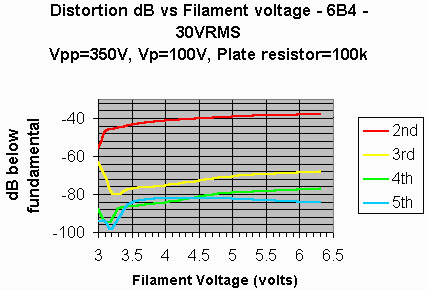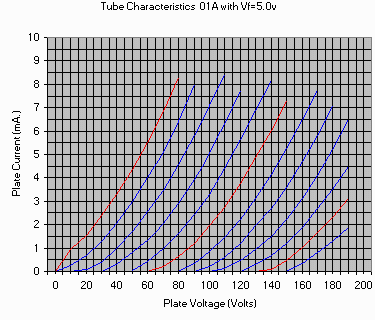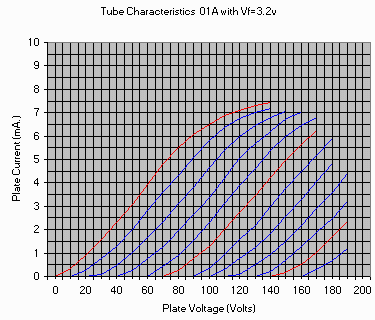
Directly Heated Triodes operated with lower voltage on the filaments - Updated.
One of the interesting effects I ran across was the effect of operating directly heated triodes at reduced filament voltages. As it turns out, this drastically reduces the distortion produced in the device. This effect seems occur on all forms of directly heated tubes, from power tubes to small signal tubes, to "battery" tubes. The effect, for reasons shown later, can be exploited in small signal applications, but is more difficult to realize in power applications.
Here are some results of data collected in the lab:
O1A. Plate load=100k, Plate supply=330V, Quiescent plate voltage=132V.
Filament Vout(rms) THD
| 5v | 10v | 0.19% |
| 20v | 0.38% | |
| 30v | 0.58% | |
| 40v | 0.79% | |
| 50v | 0.90% | |
| 3.15v | 10v | 0.03% |
| 20v | 0.06% | |
| 30v | 0.10% | |
| 40v | 0.20% | |
| 50v | 1.5% |
Even large tubes show this effect. Here's data on a 1619 (similar to a 6L6, except it has a directly heated 2.5v filament instead of the heater-cathode.of the 6L6. The data is for a 330v supply, 25k load resistor, with the bias adjusted for 150 volts on the plate.
Filament Vout(rms) THD
| 2.5v | 10v | 0.70% |
| 20v | 1.60% | |
| 30v | 2.50% | |
| 40v | 3.60% | |
| 50v | 5.00% | |
| 1.4v | 10v | 0.23% |
| 20v | 0.40% | |
| 30v | 0.55% | |
| 40v | 0.80% | |
| 50v | 1.10% |
Here is data for a type 26. This was the "best" of seven tested 26 devices. The conditions are 330 volt plate supply, 100k plate load, quiescent voltage adjusted for 132 volts.
Filament Vout(rms) THD
| 1.5v | 10v | 0.28% |
| 20v | 0.58% | |
| 30v | 0.90% | |
| 40v | 1.20% | |
| 50v | 1.50% | |
| 0.8v | 10v | 0.03% |
| 20v | 0.06% | |
| 30v | 0.10% | |
| 40v | 0.18% | |
| 50v | 0.34% |
This effect occurs whether the filament is AC powered or DC powered, and is not hugely sensitive to the voltage. Here's data for a 1U4 battery tube illustrating the effect of filament voltage. The conditions are 220 volt plate supply, bias adjusted for about 109 volts quiescent. The plate load was 200k, and the output level was maintained at 20 vrms.
Filament THD
| 1.4v | 1.90% |
| 1.3v | 1.85% |
| 1.2v | 1.80% |
| 1.0v | 1.50% |
| 0.9v | 1.10% |
| 0.85v | 0.60% |
Effect as a Function of Voltage - Harmonic Components
One of the possible problems with the application of this effect is a potential cancellation of the second harmonic component, at the expense of the other harmonic components. This does not have to be the case. In the picture below, a 6B4 was characterized as a "small signal tube" - exotic, but possible. The picture shows that the higher order components are reduced even more than the second harmonic, until you get to very low filament voltages. Here's the picture:

The effect explained
In order to understand what was going on, I built up a curve tracer to view the tube characteristics. I used the 01A as the test device, as the effect with this device is representative of the class. The curves shown were obtained by tracing the curves from the scope, then entering the values into an Excel spreadsheet. (There was a previous version I put on the web page that was a "picture" of the tracings. It was ugly enough to redo in the format now shown). The curves below both use 2 grid volts per step. The 0, -10, and -20 volt biases are shown in red for better clarity.


This is VERY interesting. The "starved" condition now includes a wide range where the mu, transconductance, and plate resistance are essentially constant for a wide range of loads... The "normal" characteristics have the familiar "plate resistance varies and gm varies, but mu is constant" shape. The starved characteristics clearly show a flattening out of the plate current (due to the starvation), but the range of constant gm and constant mu is also evident. The flattening out of the characteristics also implies that this effect would be harder to implement in a power amplifier situation.
The "datasheet" values for this tube are rp=10k, gm=0.8mS, mu=8. Reading the values from the above tube curves, near the datasheet operating point, I get rp=8.8k, gm=0.95mS, mu=7.5. Reading the values for the starved filament condition, again near the same operating point, the values are rp=13.5k, gm=0.63mS, mu=8.5. In a real circuit, there is a measureable increase in circuit gain as the filament voltage is lowered, consistent with the tube curves. The big difference, However, is still the wide range over which the tube parameters are essentially constant.
So maybe we have explained the mystery; by starving the filament in DHT devices, the tube characteristics show a substantial region of not only constant mu, but constant gm and constant rp, thereby essentially removing all distortion causing mechanisms.
Incidentally, I have been "life testing" a 1U5 running under starved filament conditions, to make sure that it is possible to exploit this effect without harming the lifetime of the tube, due to "cathode" stripping. Although this would normally consume much time, preliminary data (after slightly over 2 weeks time so far), there has been no degradation in the transconductance measured of either the starved tube, or on the"normally operated" (control) 1U5 concurrently being tested.
For further study: Indirectly heated triodes do not have this effect with one exception: the 27.
Steve